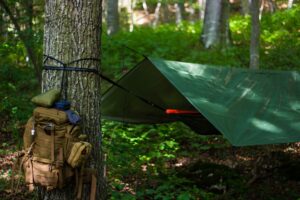How to choose shelters/tarps
How to choose shelters/tarps
Bushcraft Tarps or Shelter is a built shelter in minutes and will protect you from bad weather.
Weight
The difference between Tarp and Tent is known in weight. The tent weighs more than 2 kilos and is more difficult to build unlike this shelter.
The Shelter it is based on the ancient past but also the present in the needs of the army and travelers. The first shelters were made of cotton, and everyone knows that cotton is a good material, but when wet it is very heavy and must be allowed to dry.
The military therefore used the material cotton impregnated against the ingress of water. This impregnation was not long-term and had to be repeated.
It was also the case that no one could reach the shelter with their hands in the rain because it would break the impregnation and water would start to drip in that place.
Ease of layout Shelter/Tarp
The Shelter often spreads between two trees, which do not have to be close together because you use a rope to attach and you use pegs to anchor the ground.
It does not matter how flat the terrain is under the shelter, unlike the position of the tent where it is necessary to have a flat.
You do not use any poles when building a shelter, but you do when nobuilding a tent yes.
Differences
Shelters are made of various fabrics, such as nylon, cotton, canvas, etc.
Your choice should be for a material that is solid, has a waterproof coating and any water column given is more than 5000.
If you build the shelter well and the water does not stick to you, the water column will be enough.
But also study the strength of sewn stitches and individual seams. There are shelters from manufacturers that have such weak loops for attachment that there is a risk of ecstasy.
Small straps are a disadvantage even in winter when you have frozen hands. It is very difficult to hit them and stretch the rope for attachment.
But if you choose correctly, you will be satisfied. The shelter will protect you from wind and rain and partly from winter. It depends on how you build the shelter.
But remember that it does not fully replace a tent with a floor.


